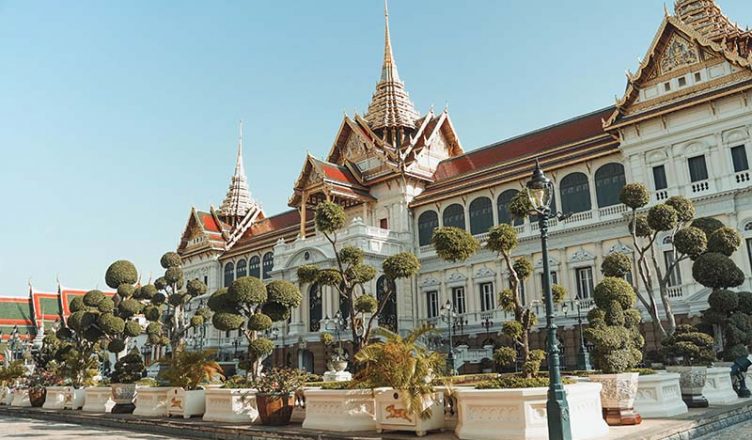It was in 1782 when the Grand Palace of Bangkok, also known as Phra Borom Maharatchawang, was indicted as the official residence of the Thai monarchy. Even though it is primarily used for ceremonies, it is still the city’s biggest draw and a pilgrimage site for devoted Buddhists.
Located inside a larger complex that also includes the sacred Wat Phra Kaew (Temple of the Emerald Buddha), these 94.5-hectare grounds are home to more than 100 structures that span 200 years of royal history and architectural experimentation.
Ratanakosin is the name of most of the city’s royal and religious buildings (old-Bangkok style). The grounds of the Grand Palace and the four remaining buildings are open to the public.
It will consume two to three hours to see everything or an extra hour with a guide. Apply for a Thailand tourist visa or regular Thailand visa for your travel requirements.
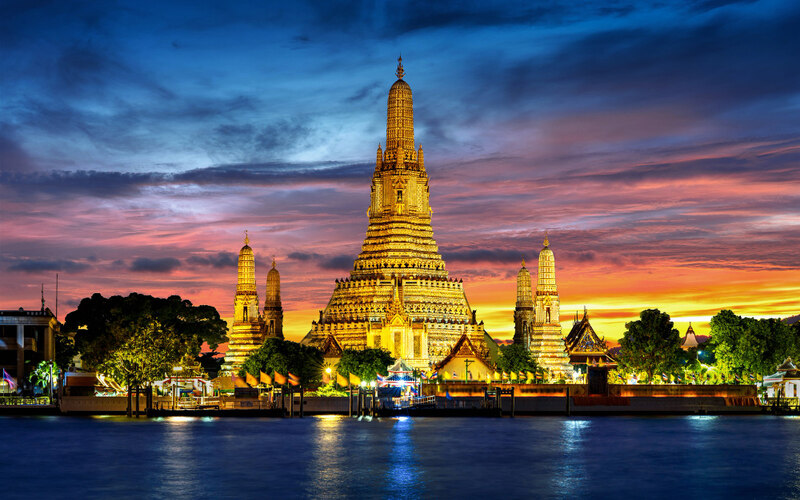 4N/5D
4N/5D
 4N/5D
4N/5D
 5N/6D
5N/6D
How to Get to The Grand Palace
The Grand Palace is located in the historic heart of Bangkok, in the Phra Nakhon district next to the Chao Phraya River. It’s easily accessible using Bangkok’s public transport systems.
- BTS Skytrain – Take the Saphan Taksin line and get off at Saphan Taksin station. Then take a short walk or taxi to the Grand Palace’s entrance.
- Boat – Take the Chao Phraya Express commuter boat and disembark at Tha Chang pier, next to the Grand Palace.
- Bus – Many local buses stop near the Grand Palace, including numbers 8, 25, 44, 47, 73, 201 and 503.
- Taxi/Tuk Tuk – Taxis and tuk tuks are readily available for hire around Bangkok. Ask the driver to take you to the Na Phra Lan Road entrance. Agree on a reasonable fare beforehand.
- MRT Subway – Take the MRT to Hua Lamphong station, then transfer to a taxi or local bus.
You can also join a guided tour which includes convenient round-trip transport from your hotel. This allows you to avoid public transport hassles.
Highlights
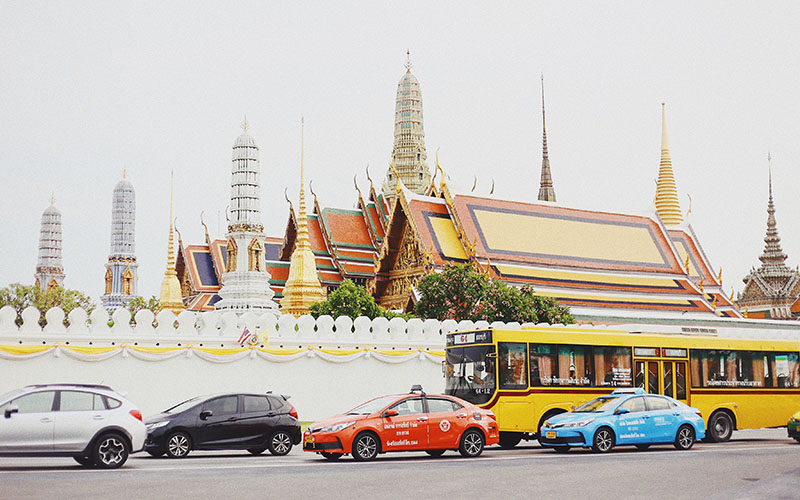
With its three soaring wings, Chakri Maha Prasat is the largest public area of Bangkok’s Grand Palace (Grand Palace Hall). It was finished in 1882 after a design by British architect John Clunish, who was stationed in Singapore, and it features an unusual fusion of Italian Renaissance and traditional Thai architecture.
As mondp tops each wing, this look is sometimes called faràng sài chá-dah (Westerner wearing a Thai classical dancer’s headdress) (a layered, heavily ornamented spire). It is claimed that a dome was initially intended for the palace’s top, but Rama V (King Chulalongkorn; r 1868-1910) was convinced to go with a Thai-style roof instead. An underhanded middle finger to the foreign colonialists occupying Asia at the time has been read into that choice. By topping his Western-inspired palace hall with a Thai-style roof, many people feel the king symbolically demonstrated Thai superiority over European culture.
The ashes of the monarchs of the Chakri dynasty are housed in the tallest of the mondp in the center, while those of the many Chakri princes who were denied the throne are kept in the mondp on each side. Dusit Hall, the last structure to the west, was built in the Ratanakosin architecture and was used for royal audiences and afterward as the royal burial hall.
Borombhiman Hall, a French-style building at the palace’s eastern end, was Rama VI’s official residence (King Vajiravudh; r 1910–25). These days, the only way to see it is through barred gates. To the west, you’ll find Amarindra Hall, which was once a courthouse but is now only used for coronations.
Until Rama VI decreed that one wife was enough for any man, even a monarch, Thai kings kept their massive harems in the inner palace area (not available to the public), guarded by combat-trained female sentries. The fictionalized epic Four Reigns by Kukrit Pramoj chronicles the life of a girl named Phloi as she develops in the Royal City, and its pages are a testament to the intrigue and rituals that took place there. The background makes it one of the interesting places to visit in Thailand.
History

When King Rama I took the throne in 1782, he ordered the construction of the grand palace complex that bears his name. People think he relocated the royal court from Thonburi, on the west bank of the Chao Phraya River, to Bangkok, on the east bank, for security reasons. The river could then serve as a moat along the city’s northern, southern, and western borders. Still, the muddy delta surrounding the city’s eastern boundary made it impossible for invaders to sneak around undetected or unimpeded.
During King Vajiravudh’s reign, the royal mansions were relocated away from the Grand Palace, allowing Chakri Mahaprasat (Grand Palace Hall) to fall into disrepair. Rama VII (King Prajadhipok; r 1925–1935) ordered a massive refurbishment of the hall in 1932, but the project went bankrupt, and the rear of the structure had to be dismantled.
Rama VIII (King Ananda Mahidol; r. 1935–1946) was mysteriously assassinated at the Grand Palace. He had been struck by a headshot and was discovered dead in bed.
In April 1981, the palace served as the headquarters for a failed coup led by General San Chitpatima against Thai Prime Minister Prem Tinsulanond. A successful coup was not achieved.
Perhaps one of the most extravagant historical burials occurred in the Grand Palace complex and nearby Sanam Luang in October 2017. An almost 50-meter-tall gilded pyre was built for the ceremony, which took a year to organize and cost a total of US$90 million. Tens of thousands of mourners wore black to the event.
In 2019, the massive Amarindra Hall hosted the coronation of the current monarch, Rama X. After the ritual, the monarch rode the royal palanquin Budtan Thong from the throne room in the hall to the Wat Phra Kaew.
Is there a specific attire requirement to enter the Grand Palace?
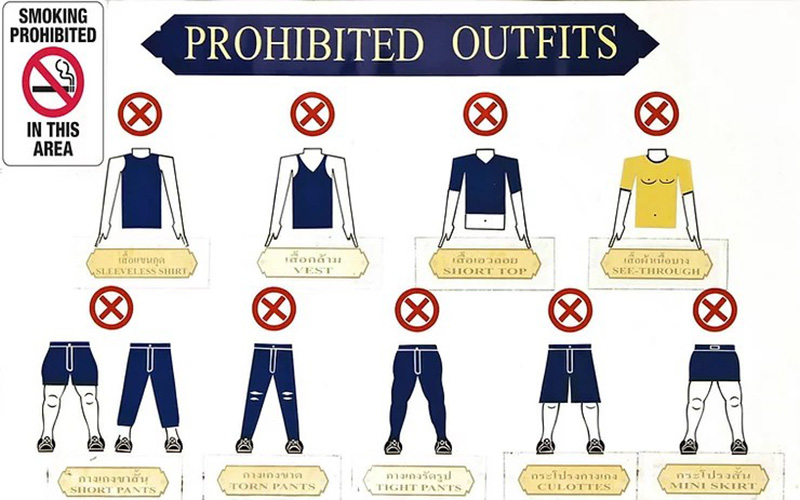
Like many other Bangkok attractions, the Grand Palace requires visitors to dress respectfully. This entails having sufficient insurance. All guests are asked to dress modestly, covering their shoulders, knees, and chests at a minimum.
Shorts and skirts/pants shorter than three-quarters of the way down the thigh are neither allowed nor sleeveless shirts, vests, or see-through tops. Travelers who show up in cycle shorts, miniskirts or pants that are too tight or too tight across the thighs will also be turned away.
Those who do not appear to be dressed suitably at the door should expect to be directed to a dressing room and given a sarong to wear before being admitted. Shoe removal is required at some palace entrances; otherwise, you are free to wear whatever you like.
The Ticket and Other Administrative Matters
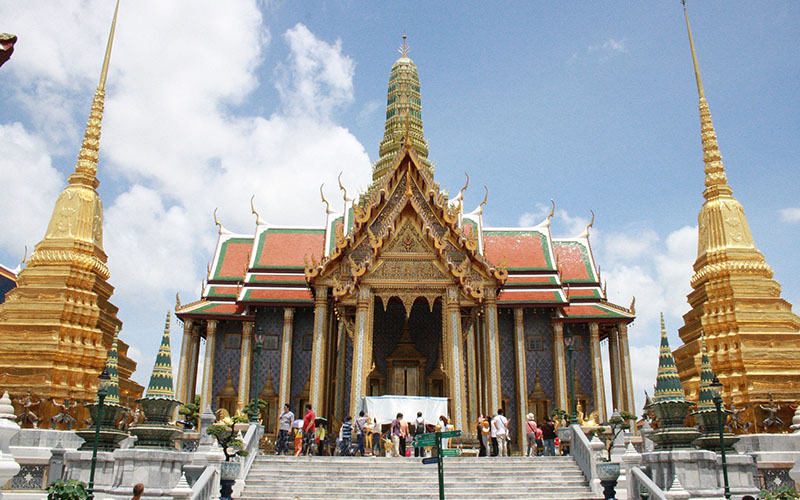
The Grand Palace is open daily from 8:30 AM until 3:30 PM. The complex closes a little earlier on some special public holidays. Make sure to get there early, ideally by 8 AM, to beat the largest crowds. There are always long queues in the afternoon. Also note the palace is exceptionally busy on weekends and holidays.
Entrance Fees
There is a 500 Baht entrance fee for foreigners to access the Grand Palace. This allows entry to the Grand Palace grounds and the Temple of the Emerald Buddha. Thais enter for free. Be sure to dress respectfully, otherwise you may be denied entry or forced to rent appropriate clothing.
Tossing Dice at the Grand Palace
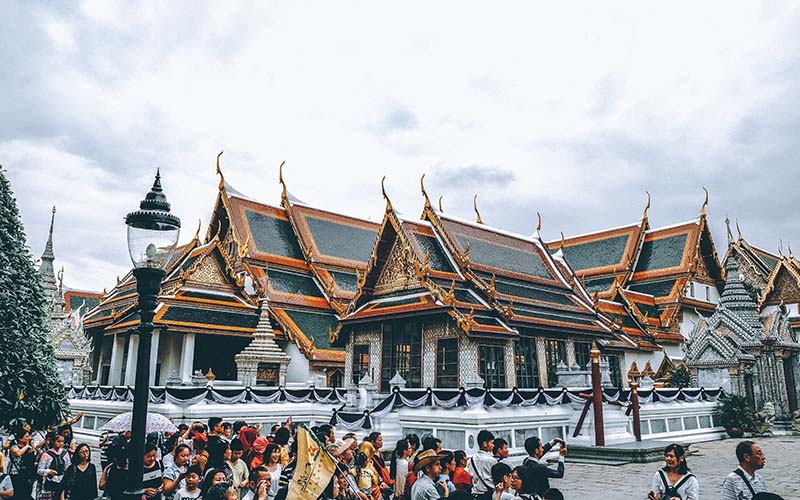
Get there first thing in the dawn to take advantage of the lower temperatures and to beat the crowds. Ignore strangers near the entrance who say the attractions are closed. Remember to bring water. The lone cafeteria in the building was closed during our visit, and the empty courtyard quickly became unbearably hot.
Hotels in the area
One of the best things about holidaying is the range of luxurious hotels in Thailand. Feung Nakorn Balcony is housed in a converted school and features 42 spacious, well-lit, bright rooms. The picturesque hotel is set in a peaceful, isolated area, far from the hustle and bustle of the city.
Asadang is a stunning antique shophouse in Chinatown, and its nine rooms will transport you back a century. The rooms may not be enormous, but they make up for it in ambiance, with a mix of antique and modern furnishings.
Arom D is a stylish hostel in the middle of trendy Tien village, with rooms that share a familiar, adorable aesthetic, a rooftop deck, shared computers, and a cozy cafe on the first floor.
Locations of Nearby Eateries
The Royal Navy Association operates the restaurant Navy Club, which boasts one of the few prime riverfront positions along Chao Phraya. Locals frequent this eatery for its views and reasonably priced, high-quality seafood fare rather than its cafeteria vibe.
Ming Lee is a quaint, traditional Thai restaurant conveniently positioned right across the street from the Grand Palace’s main gate, making it the perfect place to refuel before continuing to the palace’s many attractions. You may also stop by Err for a cocktail and some spicy bar snacks with a Thai twist. There are innumerable Thai food dishes that you can gorge during your holiday.
Beware of Scams
Unfortunately, various scams target tourists near the Grand Palace. Beware of the following:
- Being told the palace is closed – It’s not true. This is to steer you toward alternate attractions.
- Fake “tourist information” desks – They will recommend expensive tours or transport. Get information only from official desks or your hotel.
- Being pressured to purchase overpriced gems – Salespeople falsely claim deals are only available that day. Do not purchase.
- Unofficial guides – They often demand inflated fees after giving a quick tour. Politely decline their help.
- Rickshaw drivers taking you to unwanted shops – Negotiate the fare upfront and clarify no stops. Use metered taxis where possible.
Tips for Visiting the Grand Palace
Follow these tips to make the most of your Grand Palace visit:
- Dress code – Cover your shoulders and knees, otherwise you’ll have to rent clothing. Besides modest clothing, also keep in mind the weather of the country before packing your luggage. For example, Thailand in January has cold and dry climate, so pack a light sweater or jacket.
- Act respectfully – Sitting or lying down is not permitted near royal monuments. Speak quietly.
- Wear cool, breathable clothing – It gets very hot, especially when crowded.
- Bring water – Hydrate regularly as you walk around. Food and drinks must be consumed outside.
- Wear proper footwear – The ground can get very hot. Comfortable shoes are best.
- Ask questions – Hire a guide or research in advance to understand what you are seeing.
- Photography allowed – But no tripods or selfie sticks blocking pathways.
Things to See at the Grand Palace, Bangkok
The Grand Palace is a vast complex with numerous highlights. Here are some key attractions not to miss:
1. Wat Phra Kaew – The Temple of the Emerald Buddha
The Wat Phra Kaew is the most important temple within the palace grounds. It enshrines the Emerald Buddha, Thailand’s most sacred and revered Buddha image, carved from a single block of nephrite jade.
The surprisingly small statue sits atop a gilded pedestal high within the temple. While you cannot walk up to the Buddha image, you can admire its exquisite craftsmanship from a distance. Murals depicting the Ramakian epic adorn the temple walls.
Outside the bot (ordination hall), see the library of Phra Mondop, with its mother-of-pearl doors and bookcases. Also gaze up at the golden Phra Si Ratana Chedi stupa containing ashes of the Buddha.
2. Golden Stupa
The Golden Stupa, also called Phra Maha Monthian, dominates the skyline. At almost 100 meters tall, this impressive stupa contains relics of the Buddha.
The stupa is built in Sri Lankan style and dates back to the Ayutthaya period. It was restored by Rama I. Cast at the base are statues of garudas – mythical Thai bird-like creatures.
Climb up the terrace to observe the gleaming stupa up-close. At certain times of day when sunlight strikes, it seems to glow and shimmer beautifully with an ethereal golden aura. Definitely pause here to admire the view.
3. Phra Mondop
Next to the Temple of the Emerald Buddha sits this elegant library in traditional Thai architectural style, called Phra Mondop. Built by Rama I to house Buddhist scriptures, it stands on pillars with a characteristic multi-tiered roof.
Admire the detailed mother-of-pearl inlay decorating the wooden doors and bookcases inside. The inscription plaque above the door says, “Knowledge Gives Us Understanding and a Clear Mind.” It’s a serene spot to take a break from the crowds.
4. Chakri Maha Prasat
The Chakri Maha Prasat is the Grand Palace’s central and largest throne hall, built in 1882 during the reign of Rama V. This imposing structure contains the royal throne and is used for important state ceremonies.
Recognizable for its tall, spiked roof, the Hall combines both European neoclassical and distinctive Thai styles. The roof is decorated with vibrant glass mosaic tiles from Venice. Inside are historical murals and Rama V’s opulent golden throne.
5. Dusit Maha Prasat
Once serving as the palace where Thai kings granted royal audiences, the Dusit Maha Prasat now houses the Palace School. Its elegant European-inspired architecture stands out among the Thai buildings.
The exterior features neoclassical columns, white walls, and green shutters. Inside, see Rama I’s intricately carved throne backed by a gold Buddha image. It offers insight into how Thailand adjusted traditions yet maintained identity when embracing Western influences.
6. Borombhiman Hall
This hall was built in 1903 as a residence for Prince Borommachote, one of King Chulalongkorn’s sons. The interior reveals splendid hand-painted murals, considered masterpieces of Thai art.
Delicate paintings cover every wall and represent Thai literature and traditional lifestyles. Admire vivid forest scenes, religious stories, and images of old Siam. The building is an excellent example of traditional Thai architecture and design.
7. Queen Sirikit Museum of Textiles
Opened in 2012, this museum showcases a collection of royal costumes and textiles assembled by Queen Sirikit. Located in the Grand Palace’s former Royal Treasury, the galleries display centuries of exquisite Thai and Lao silk textiles.
See King Rama V’s full formal regalia, antique Thai dolls dressed in intricate costumes, and Queen Sirikit’s elegant modern garments blending Western and Thai styles. It celebrates Thailand’s textile heritage and the crucial role of silk production.
The Grand Palace’s diverse attractions offer a fascinating lens into Thailand’s rich culture and heritage. Take time to immerse yourself in the temples, pavilions, museums, and architecture.
Don’t try to see absolutely everything in one visit. Focus on a few highlights that interest you most.
Best Time to Visit the Grand Palace
The Grand Palace can be visited year-round. The weather is hot most of the year in Bangkok.
Peak season is from November to March when weather is cooler and drier. Expect large crowds, especially in December and January.
April brings warmer temperatures and is very busy with Thai New Year celebrations. May to October sees high heat and humidity with occasional rain showers. These months are less crowded.
Avoid public holidays and weekends when locals flock to the Grand Palace. Ideally visit midweek and early in the day. Also consider a half-day guided tour for easy access.
With its regal history, architecture and treasures, the Grand Palace is an unmissable Bangkok attraction. Follow this guide to make the most of your visit to this magnificent Thailand landmark.
Conclusion
Bangkok’s Grand Palace is one of the must-see places in Thailand. Its captivating history, gilded architecture and idyllic location all make it a mandatory addition to your itinerary.
